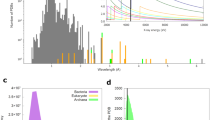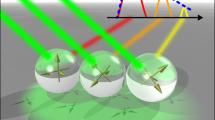Abstract
CONSIDERABLE discussion has recently been devoted to the use of vector maps in crystal analysis1 based on the Patterson method2. Although much use has been made of this method in the insulin structure1,3 the complexity of the problem and the inadequacy of the existing X-ray data to yield a solution in terms of atomic positions do not appear to have been sufficiently emphasized. It is quite obvious that fifty-nine relative measurements of amplitude cannot define a structure consisting of several thousand atoms. So far as these measurements go, the structure is effectively a continuous distribution of scattering matter, and every arbitrary assignment of phase constants to the amplitudes will yield a solution. As individual atoms cannot appear in any of these solutions, there does not seem to be any rigid criterion in favour of one any more than another. The Patterson maps, which summarize the X-ray measurements, do not remove this ambiguity because, for a similar reason, we do not know what meaning to attach to the peaks in these maps. The suggestion that certain concentrations of atoms in the molecule can be treated as point scattering sources does not seem to constitute even a reasonable approximation. As no large gaps between the atoms are likely, it may also be very difficult to distinguish between regions of high and low density which are due to real features in the structure, and those which are due to unavoidable deficiencies in the series representing it.
This is a preview of subscription content, access via your institution
Access options
Subscribe to this journal
Receive 51 print issues and online access
$199.00 per year
only $3.90 per issue
Buy this article
- Purchase on Springer Link
- Instant access to full article PDF
Prices may be subject to local taxes which are calculated during checkout
Similar content being viewed by others
References
Langmuir and Wrinch, NATURE, 142, 581 (1938); Wrinch, NATURE, 142, 955 (1938); Neville, NATURE, 142, 994 (1938).
Patterson, Z. Krist., 90, 517 (1935).
Crowfoot, Proc. Roy. Soc., A, 164, 580 (1938).
Harker, J. Chem. Phys., 4, 381 (1936); Llewellyn, Cox and Goodwin, J. Chem. Soc., 883 (1937).
Robertson, J. Chem. Soc., 615 (1935); 1195 (1936).
Robertson and Woodward, J. Chem. Soc., 219 (1937).
Robertson and Woodward, J. Chem. Soc., (1939, in preparation).
Author information
Authors and Affiliations
Rights and permissions
About this article
Cite this article
ROBERTSON, J. Vector Maps and Heavy Atoms in Crystal Analysis and the Insulin Structure. Nature 143, 75–76 (1939). https://doi.org/10.1038/143075a0
Published:
Issue Date:
DOI: https://doi.org/10.1038/143075a0
This article is cited by
-
Eine direkte r�ntgenographische Molek�lstrukturbestimmung durch Vergleich isomorpher Kristallstrukturen
Die Naturwissenschaften (1944)
-
The Structure of the Globular Proteins
Nature (1939)
-
The Cyclol Theory and the Structure of Insulin
Nature (1939)
Comments
By submitting a comment you agree to abide by our Terms and Community Guidelines. If you find something abusive or that does not comply with our terms or guidelines please flag it as inappropriate.



